Comprehensive Analysis of Medication Errors: Nursing Research Report
VerifiedAdded on 2021/06/15
|7
|1621
|49
Report
AI Summary
This report, focused on evidence-based nursing research, examines the critical issue of medication errors within healthcare settings. It defines medication errors and explores various contributing factors, including issues in prescription, administration, and monitoring. The report highlights several strategies to mitigate these errors, such as the 'Five Rights of Medication Administration,' medical reconciliation procedures, double-checking processes, and computerized provider order entry systems. It analyzes the strengths and limitations of each strategy, drawing on research articles to establish the validity and trustworthiness of the proposed interventions. The report emphasizes the importance of patient safety and the nurse's role in preventing medication errors, concluding that a multi-faceted approach, incorporating the discussed strategies, is essential for ensuring the correct and safe administration of medications.
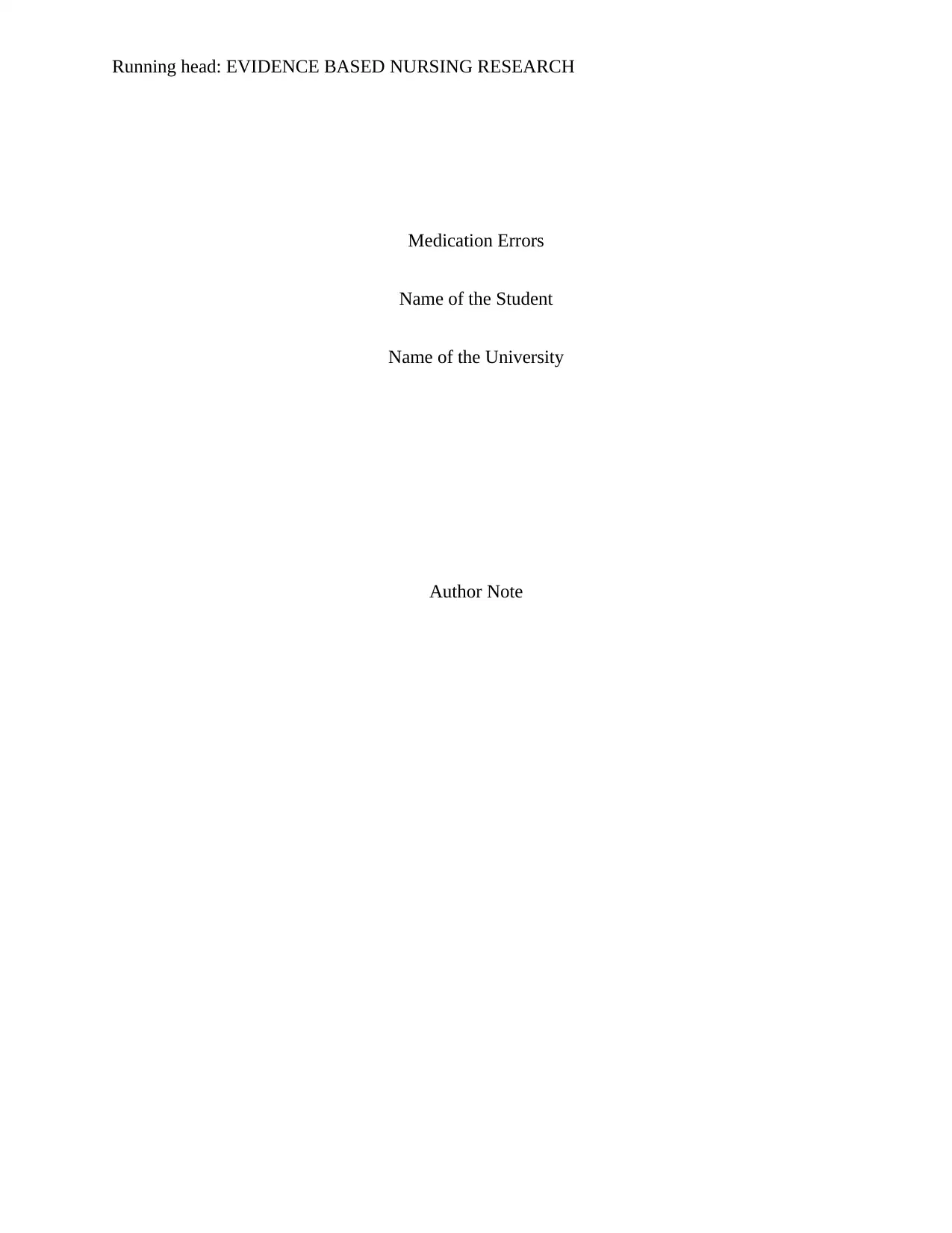
Running head: EVIDENCE BASED NURSING RESEARCH
Medication Errors
Name of the Student
Name of the University
Author Note
Medication Errors
Name of the Student
Name of the University
Author Note
Paraphrase This Document
Need a fresh take? Get an instant paraphrase of this document with our AI Paraphraser
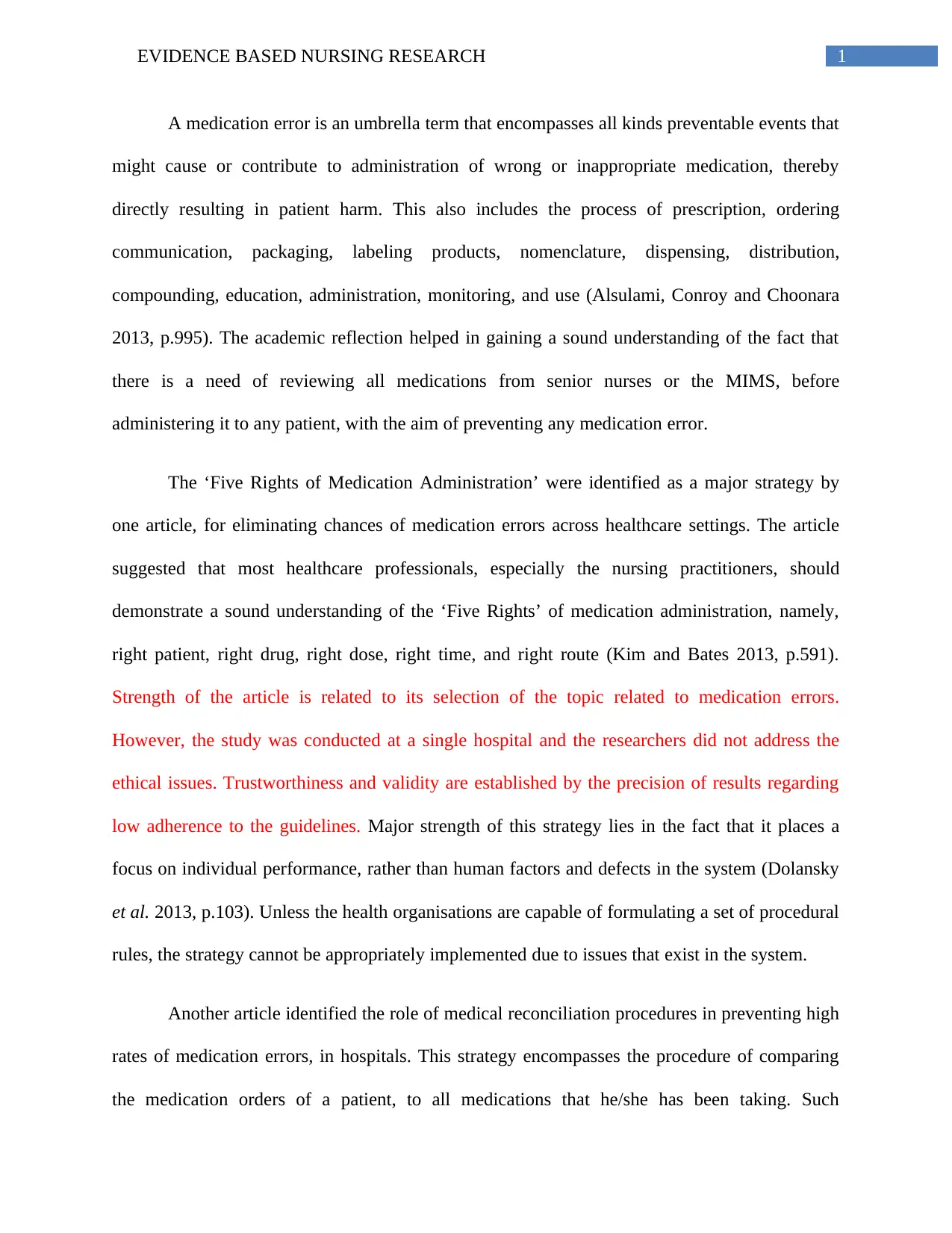
1EVIDENCE BASED NURSING RESEARCH
A medication error is an umbrella term that encompasses all kinds preventable events that
might cause or contribute to administration of wrong or inappropriate medication, thereby
directly resulting in patient harm. This also includes the process of prescription, ordering
communication, packaging, labeling products, nomenclature, dispensing, distribution,
compounding, education, administration, monitoring, and use (Alsulami, Conroy and Choonara
2013, p.995). The academic reflection helped in gaining a sound understanding of the fact that
there is a need of reviewing all medications from senior nurses or the MIMS, before
administering it to any patient, with the aim of preventing any medication error.
The ‘Five Rights of Medication Administration’ were identified as a major strategy by
one article, for eliminating chances of medication errors across healthcare settings. The article
suggested that most healthcare professionals, especially the nursing practitioners, should
demonstrate a sound understanding of the ‘Five Rights’ of medication administration, namely,
right patient, right drug, right dose, right time, and right route (Kim and Bates 2013, p.591).
Strength of the article is related to its selection of the topic related to medication errors.
However, the study was conducted at a single hospital and the researchers did not address the
ethical issues. Trustworthiness and validity are established by the precision of results regarding
low adherence to the guidelines. Major strength of this strategy lies in the fact that it places a
focus on individual performance, rather than human factors and defects in the system (Dolansky
et al. 2013, p.103). Unless the health organisations are capable of formulating a set of procedural
rules, the strategy cannot be appropriately implemented due to issues that exist in the system.
Another article identified the role of medical reconciliation procedures in preventing high
rates of medication errors, in hospitals. This strategy encompasses the procedure of comparing
the medication orders of a patient, to all medications that he/she has been taking. Such
A medication error is an umbrella term that encompasses all kinds preventable events that
might cause or contribute to administration of wrong or inappropriate medication, thereby
directly resulting in patient harm. This also includes the process of prescription, ordering
communication, packaging, labeling products, nomenclature, dispensing, distribution,
compounding, education, administration, monitoring, and use (Alsulami, Conroy and Choonara
2013, p.995). The academic reflection helped in gaining a sound understanding of the fact that
there is a need of reviewing all medications from senior nurses or the MIMS, before
administering it to any patient, with the aim of preventing any medication error.
The ‘Five Rights of Medication Administration’ were identified as a major strategy by
one article, for eliminating chances of medication errors across healthcare settings. The article
suggested that most healthcare professionals, especially the nursing practitioners, should
demonstrate a sound understanding of the ‘Five Rights’ of medication administration, namely,
right patient, right drug, right dose, right time, and right route (Kim and Bates 2013, p.591).
Strength of the article is related to its selection of the topic related to medication errors.
However, the study was conducted at a single hospital and the researchers did not address the
ethical issues. Trustworthiness and validity are established by the precision of results regarding
low adherence to the guidelines. Major strength of this strategy lies in the fact that it places a
focus on individual performance, rather than human factors and defects in the system (Dolansky
et al. 2013, p.103). Unless the health organisations are capable of formulating a set of procedural
rules, the strategy cannot be appropriately implemented due to issues that exist in the system.
Another article identified the role of medical reconciliation procedures in preventing high
rates of medication errors, in hospitals. This strategy encompasses the procedure of comparing
the medication orders of a patient, to all medications that he/she has been taking. Such
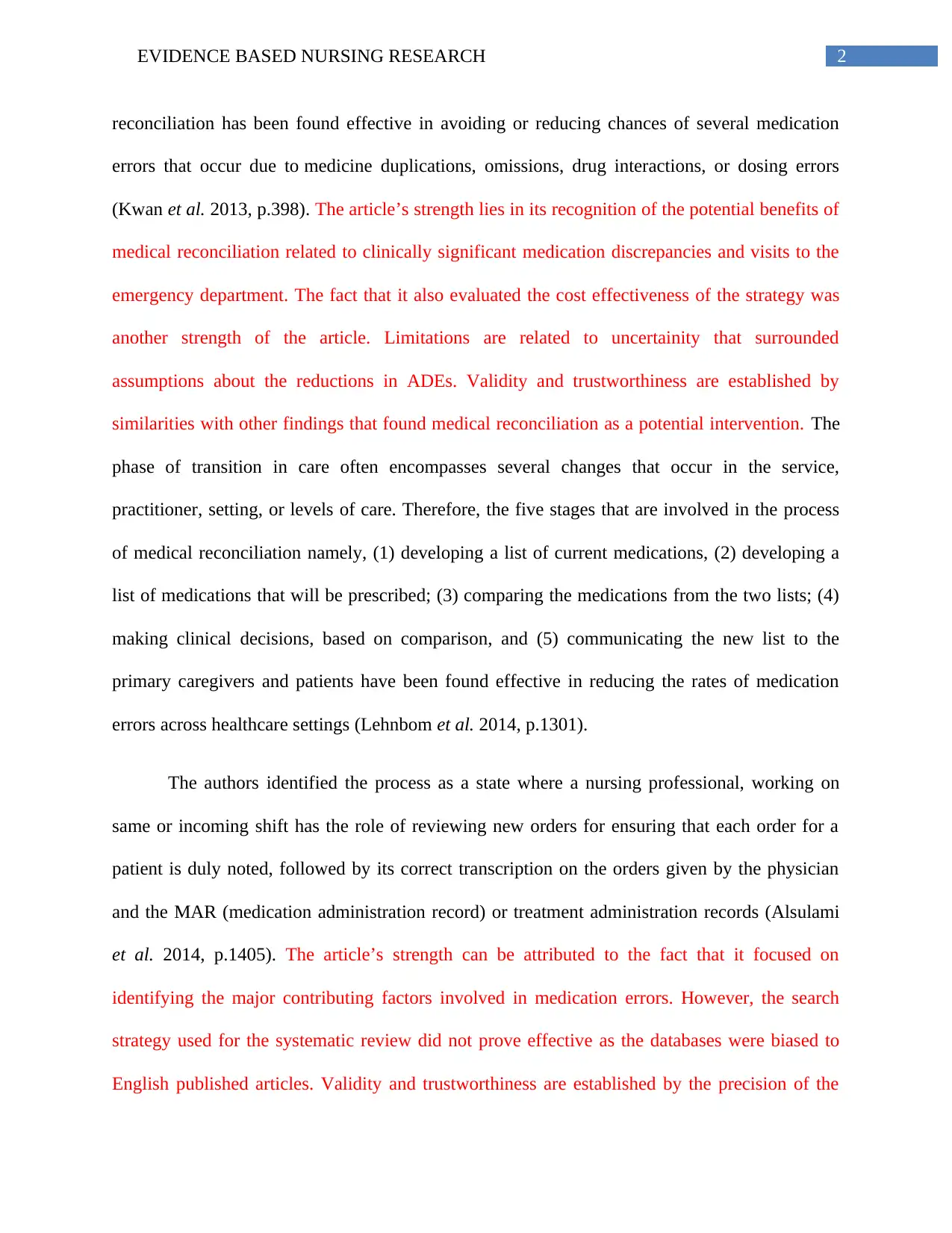
2EVIDENCE BASED NURSING RESEARCH
reconciliation has been found effective in avoiding or reducing chances of several medication
errors that occur due to medicine duplications, omissions, drug interactions, or dosing errors
(Kwan et al. 2013, p.398). The article’s strength lies in its recognition of the potential benefits of
medical reconciliation related to clinically significant medication discrepancies and visits to the
emergency department. The fact that it also evaluated the cost effectiveness of the strategy was
another strength of the article. Limitations are related to uncertainity that surrounded
assumptions about the reductions in ADEs. Validity and trustworthiness are established by
similarities with other findings that found medical reconciliation as a potential intervention. The
phase of transition in care often encompasses several changes that occur in the service,
practitioner, setting, or levels of care. Therefore, the five stages that are involved in the process
of medical reconciliation namely, (1) developing a list of current medications, (2) developing a
list of medications that will be prescribed; (3) comparing the medications from the two lists; (4)
making clinical decisions, based on comparison, and (5) communicating the new list to the
primary caregivers and patients have been found effective in reducing the rates of medication
errors across healthcare settings (Lehnbom et al. 2014, p.1301).
The authors identified the process as a state where a nursing professional, working on
same or incoming shift has the role of reviewing new orders for ensuring that each order for a
patient is duly noted, followed by its correct transcription on the orders given by the physician
and the MAR (medication administration record) or treatment administration records (Alsulami
et al. 2014, p.1405). The article’s strength can be attributed to the fact that it focused on
identifying the major contributing factors involved in medication errors. However, the search
strategy used for the systematic review did not prove effective as the databases were biased to
English published articles. Validity and trustworthiness are established by the precision of the
reconciliation has been found effective in avoiding or reducing chances of several medication
errors that occur due to medicine duplications, omissions, drug interactions, or dosing errors
(Kwan et al. 2013, p.398). The article’s strength lies in its recognition of the potential benefits of
medical reconciliation related to clinically significant medication discrepancies and visits to the
emergency department. The fact that it also evaluated the cost effectiveness of the strategy was
another strength of the article. Limitations are related to uncertainity that surrounded
assumptions about the reductions in ADEs. Validity and trustworthiness are established by
similarities with other findings that found medical reconciliation as a potential intervention. The
phase of transition in care often encompasses several changes that occur in the service,
practitioner, setting, or levels of care. Therefore, the five stages that are involved in the process
of medical reconciliation namely, (1) developing a list of current medications, (2) developing a
list of medications that will be prescribed; (3) comparing the medications from the two lists; (4)
making clinical decisions, based on comparison, and (5) communicating the new list to the
primary caregivers and patients have been found effective in reducing the rates of medication
errors across healthcare settings (Lehnbom et al. 2014, p.1301).
The authors identified the process as a state where a nursing professional, working on
same or incoming shift has the role of reviewing new orders for ensuring that each order for a
patient is duly noted, followed by its correct transcription on the orders given by the physician
and the MAR (medication administration record) or treatment administration records (Alsulami
et al. 2014, p.1405). The article’s strength can be attributed to the fact that it focused on
identifying the major contributing factors involved in medication errors. However, the search
strategy used for the systematic review did not prove effective as the databases were biased to
English published articles. Validity and trustworthiness are established by the precision of the
⊘ This is a preview!⊘
Do you want full access?
Subscribe today to unlock all pages.

Trusted by 1+ million students worldwide
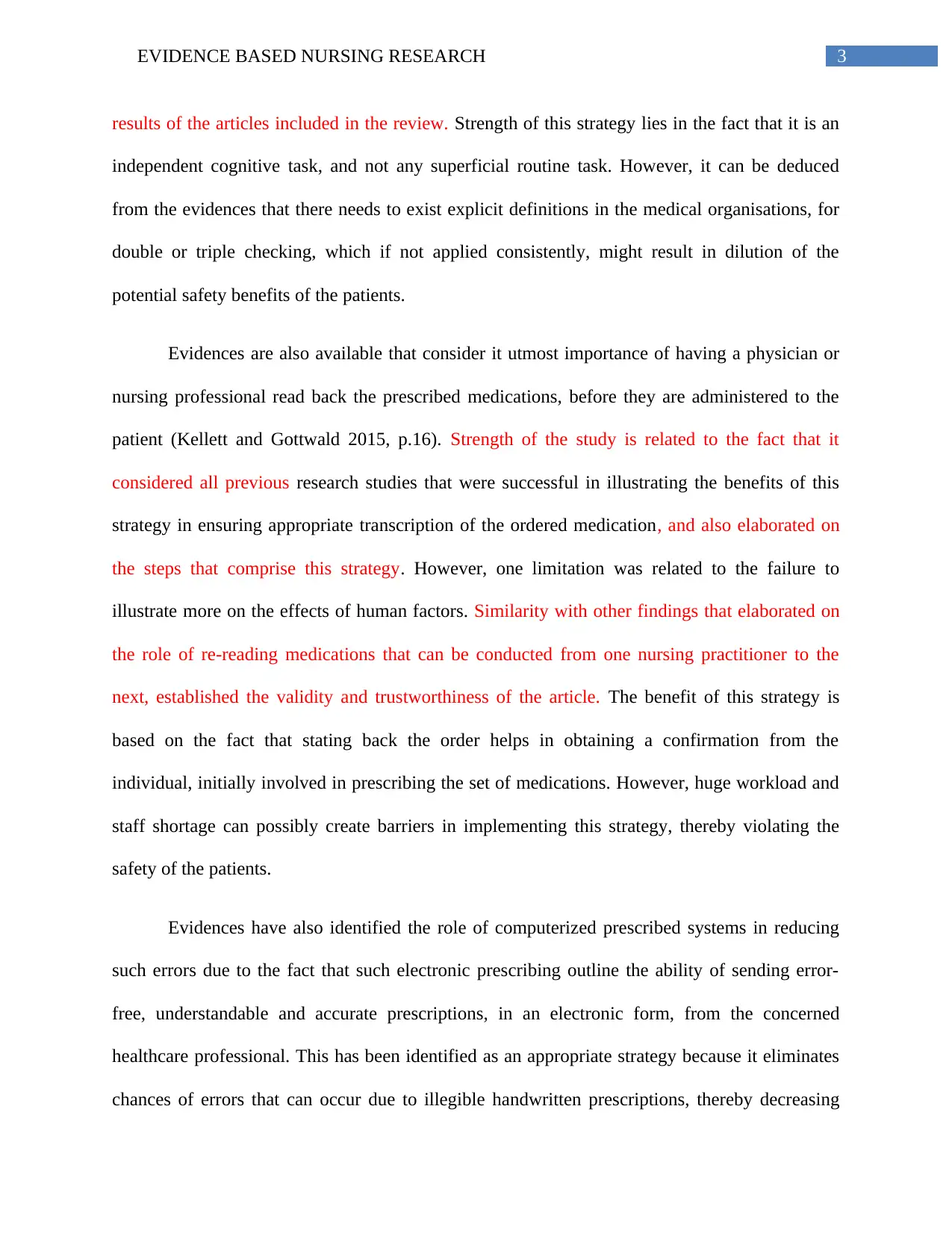
3EVIDENCE BASED NURSING RESEARCH
results of the articles included in the review. Strength of this strategy lies in the fact that it is an
independent cognitive task, and not any superficial routine task. However, it can be deduced
from the evidences that there needs to exist explicit definitions in the medical organisations, for
double or triple checking, which if not applied consistently, might result in dilution of the
potential safety benefits of the patients.
Evidences are also available that consider it utmost importance of having a physician or
nursing professional read back the prescribed medications, before they are administered to the
patient (Kellett and Gottwald 2015, p.16). Strength of the study is related to the fact that it
considered all previous research studies that were successful in illustrating the benefits of this
strategy in ensuring appropriate transcription of the ordered medication, and also elaborated on
the steps that comprise this strategy. However, one limitation was related to the failure to
illustrate more on the effects of human factors. Similarity with other findings that elaborated on
the role of re-reading medications that can be conducted from one nursing practitioner to the
next, established the validity and trustworthiness of the article. The benefit of this strategy is
based on the fact that stating back the order helps in obtaining a confirmation from the
individual, initially involved in prescribing the set of medications. However, huge workload and
staff shortage can possibly create barriers in implementing this strategy, thereby violating the
safety of the patients.
Evidences have also identified the role of computerized prescribed systems in reducing
such errors due to the fact that such electronic prescribing outline the ability of sending error-
free, understandable and accurate prescriptions, in an electronic form, from the concerned
healthcare professional. This has been identified as an appropriate strategy because it eliminates
chances of errors that can occur due to illegible handwritten prescriptions, thereby decreasing
results of the articles included in the review. Strength of this strategy lies in the fact that it is an
independent cognitive task, and not any superficial routine task. However, it can be deduced
from the evidences that there needs to exist explicit definitions in the medical organisations, for
double or triple checking, which if not applied consistently, might result in dilution of the
potential safety benefits of the patients.
Evidences are also available that consider it utmost importance of having a physician or
nursing professional read back the prescribed medications, before they are administered to the
patient (Kellett and Gottwald 2015, p.16). Strength of the study is related to the fact that it
considered all previous research studies that were successful in illustrating the benefits of this
strategy in ensuring appropriate transcription of the ordered medication, and also elaborated on
the steps that comprise this strategy. However, one limitation was related to the failure to
illustrate more on the effects of human factors. Similarity with other findings that elaborated on
the role of re-reading medications that can be conducted from one nursing practitioner to the
next, established the validity and trustworthiness of the article. The benefit of this strategy is
based on the fact that stating back the order helps in obtaining a confirmation from the
individual, initially involved in prescribing the set of medications. However, huge workload and
staff shortage can possibly create barriers in implementing this strategy, thereby violating the
safety of the patients.
Evidences have also identified the role of computerized prescribed systems in reducing
such errors due to the fact that such electronic prescribing outline the ability of sending error-
free, understandable and accurate prescriptions, in an electronic form, from the concerned
healthcare professional. This has been identified as an appropriate strategy because it eliminates
chances of errors that can occur due to illegible handwritten prescriptions, thereby decreasing
Paraphrase This Document
Need a fresh take? Get an instant paraphrase of this document with our AI Paraphraser
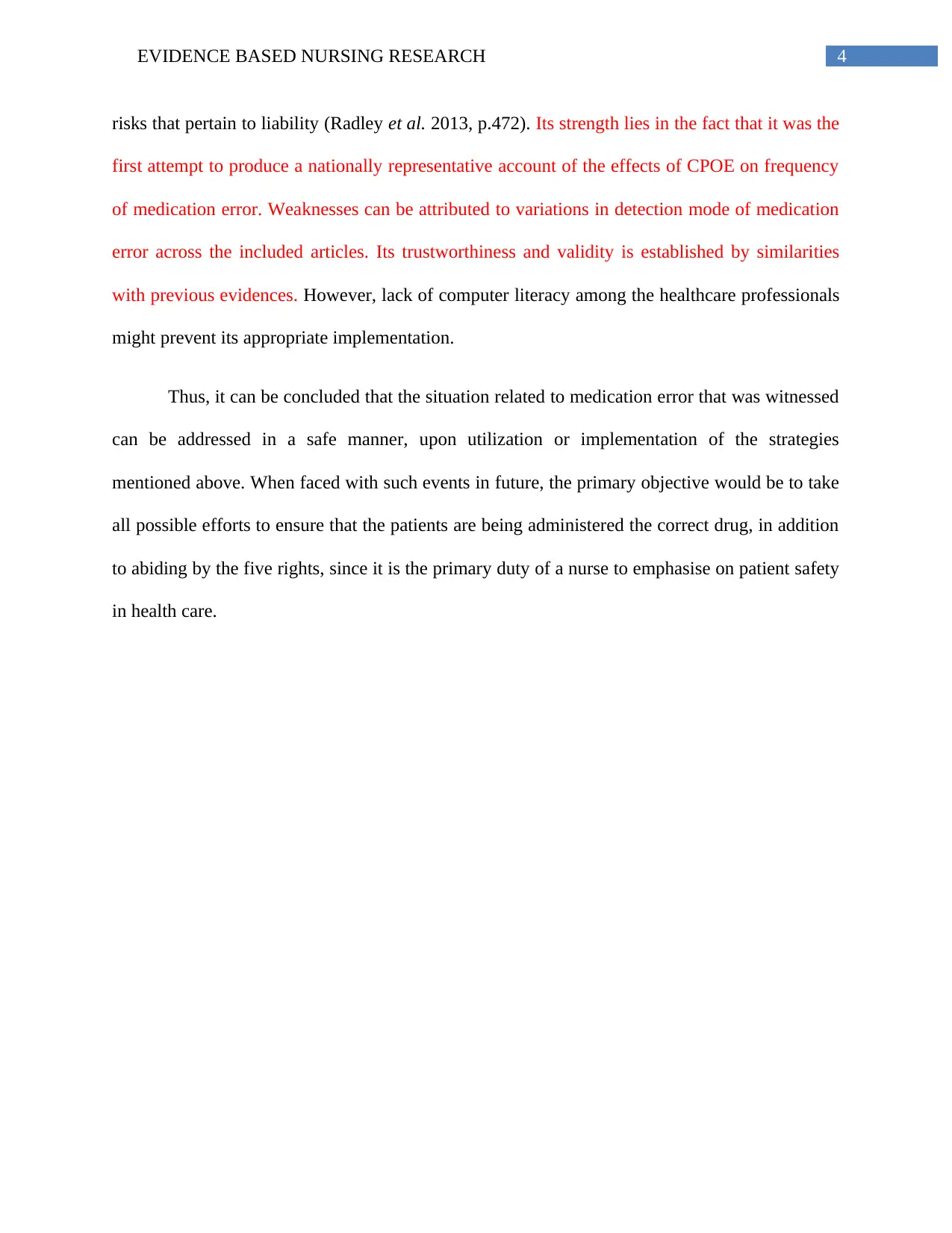
4EVIDENCE BASED NURSING RESEARCH
risks that pertain to liability (Radley et al. 2013, p.472). Its strength lies in the fact that it was the
first attempt to produce a nationally representative account of the effects of CPOE on frequency
of medication error. Weaknesses can be attributed to variations in detection mode of medication
error across the included articles. Its trustworthiness and validity is established by similarities
with previous evidences. However, lack of computer literacy among the healthcare professionals
might prevent its appropriate implementation.
Thus, it can be concluded that the situation related to medication error that was witnessed
can be addressed in a safe manner, upon utilization or implementation of the strategies
mentioned above. When faced with such events in future, the primary objective would be to take
all possible efforts to ensure that the patients are being administered the correct drug, in addition
to abiding by the five rights, since it is the primary duty of a nurse to emphasise on patient safety
in health care.
risks that pertain to liability (Radley et al. 2013, p.472). Its strength lies in the fact that it was the
first attempt to produce a nationally representative account of the effects of CPOE on frequency
of medication error. Weaknesses can be attributed to variations in detection mode of medication
error across the included articles. Its trustworthiness and validity is established by similarities
with previous evidences. However, lack of computer literacy among the healthcare professionals
might prevent its appropriate implementation.
Thus, it can be concluded that the situation related to medication error that was witnessed
can be addressed in a safe manner, upon utilization or implementation of the strategies
mentioned above. When faced with such events in future, the primary objective would be to take
all possible efforts to ensure that the patients are being administered the correct drug, in addition
to abiding by the five rights, since it is the primary duty of a nurse to emphasise on patient safety
in health care.
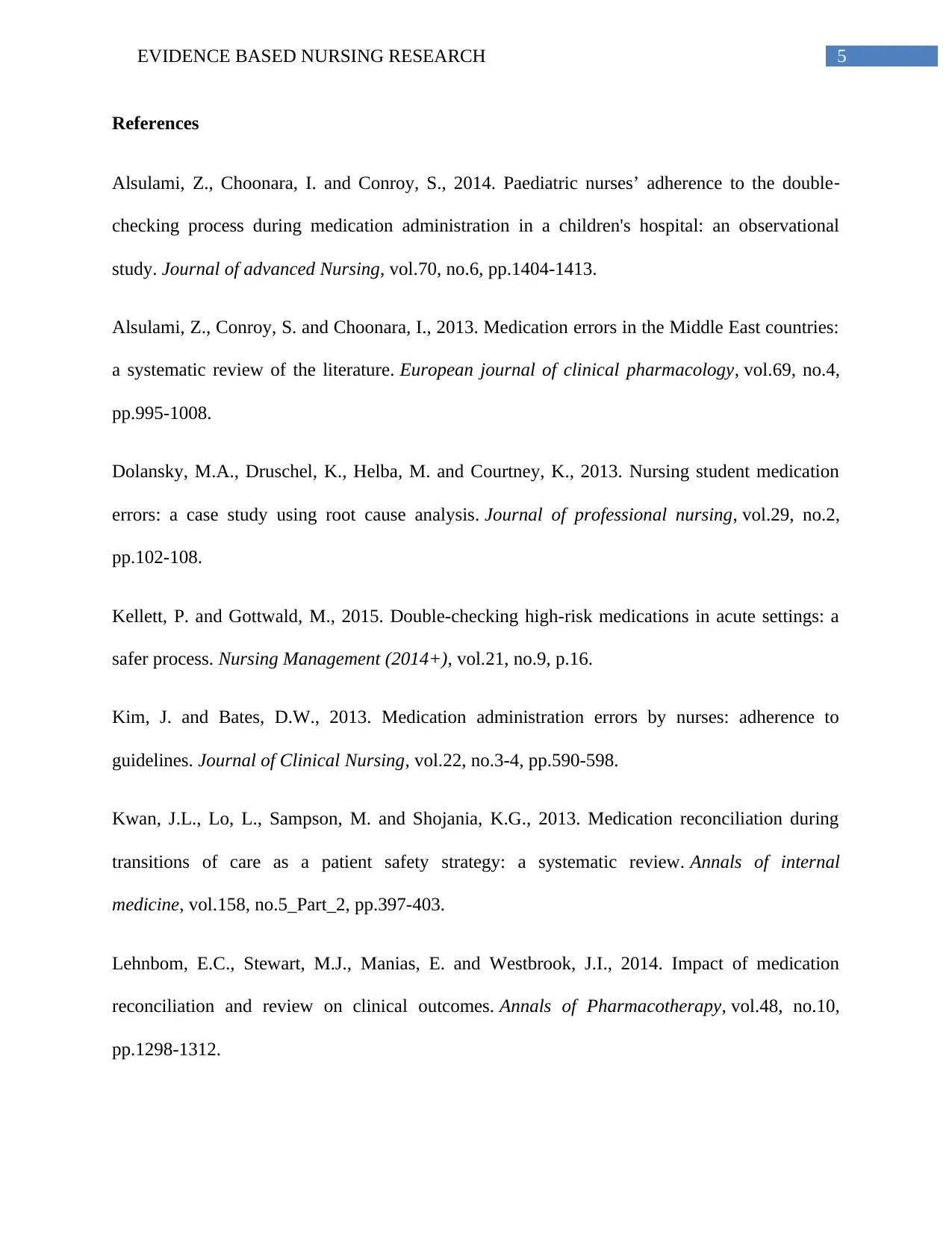
5EVIDENCE BASED NURSING RESEARCH
References
Alsulami, Z., Choonara, I. and Conroy, S., 2014. Paediatric nurses’ adherence to the double‐
checking process during medication administration in a children's hospital: an observational
study. Journal of advanced Nursing, vol.70, no.6, pp.1404-1413.
Alsulami, Z., Conroy, S. and Choonara, I., 2013. Medication errors in the Middle East countries:
a systematic review of the literature. European journal of clinical pharmacology, vol.69, no.4,
pp.995-1008.
Dolansky, M.A., Druschel, K., Helba, M. and Courtney, K., 2013. Nursing student medication
errors: a case study using root cause analysis. Journal of professional nursing, vol.29, no.2,
pp.102-108.
Kellett, P. and Gottwald, M., 2015. Double-checking high-risk medications in acute settings: a
safer process. Nursing Management (2014+), vol.21, no.9, p.16.
Kim, J. and Bates, D.W., 2013. Medication administration errors by nurses: adherence to
guidelines. Journal of Clinical Nursing, vol.22, no.3-4, pp.590-598.
Kwan, J.L., Lo, L., Sampson, M. and Shojania, K.G., 2013. Medication reconciliation during
transitions of care as a patient safety strategy: a systematic review. Annals of internal
medicine, vol.158, no.5_Part_2, pp.397-403.
Lehnbom, E.C., Stewart, M.J., Manias, E. and Westbrook, J.I., 2014. Impact of medication
reconciliation and review on clinical outcomes. Annals of Pharmacotherapy, vol.48, no.10,
pp.1298-1312.
References
Alsulami, Z., Choonara, I. and Conroy, S., 2014. Paediatric nurses’ adherence to the double‐
checking process during medication administration in a children's hospital: an observational
study. Journal of advanced Nursing, vol.70, no.6, pp.1404-1413.
Alsulami, Z., Conroy, S. and Choonara, I., 2013. Medication errors in the Middle East countries:
a systematic review of the literature. European journal of clinical pharmacology, vol.69, no.4,
pp.995-1008.
Dolansky, M.A., Druschel, K., Helba, M. and Courtney, K., 2013. Nursing student medication
errors: a case study using root cause analysis. Journal of professional nursing, vol.29, no.2,
pp.102-108.
Kellett, P. and Gottwald, M., 2015. Double-checking high-risk medications in acute settings: a
safer process. Nursing Management (2014+), vol.21, no.9, p.16.
Kim, J. and Bates, D.W., 2013. Medication administration errors by nurses: adherence to
guidelines. Journal of Clinical Nursing, vol.22, no.3-4, pp.590-598.
Kwan, J.L., Lo, L., Sampson, M. and Shojania, K.G., 2013. Medication reconciliation during
transitions of care as a patient safety strategy: a systematic review. Annals of internal
medicine, vol.158, no.5_Part_2, pp.397-403.
Lehnbom, E.C., Stewart, M.J., Manias, E. and Westbrook, J.I., 2014. Impact of medication
reconciliation and review on clinical outcomes. Annals of Pharmacotherapy, vol.48, no.10,
pp.1298-1312.
⊘ This is a preview!⊘
Do you want full access?
Subscribe today to unlock all pages.

Trusted by 1+ million students worldwide
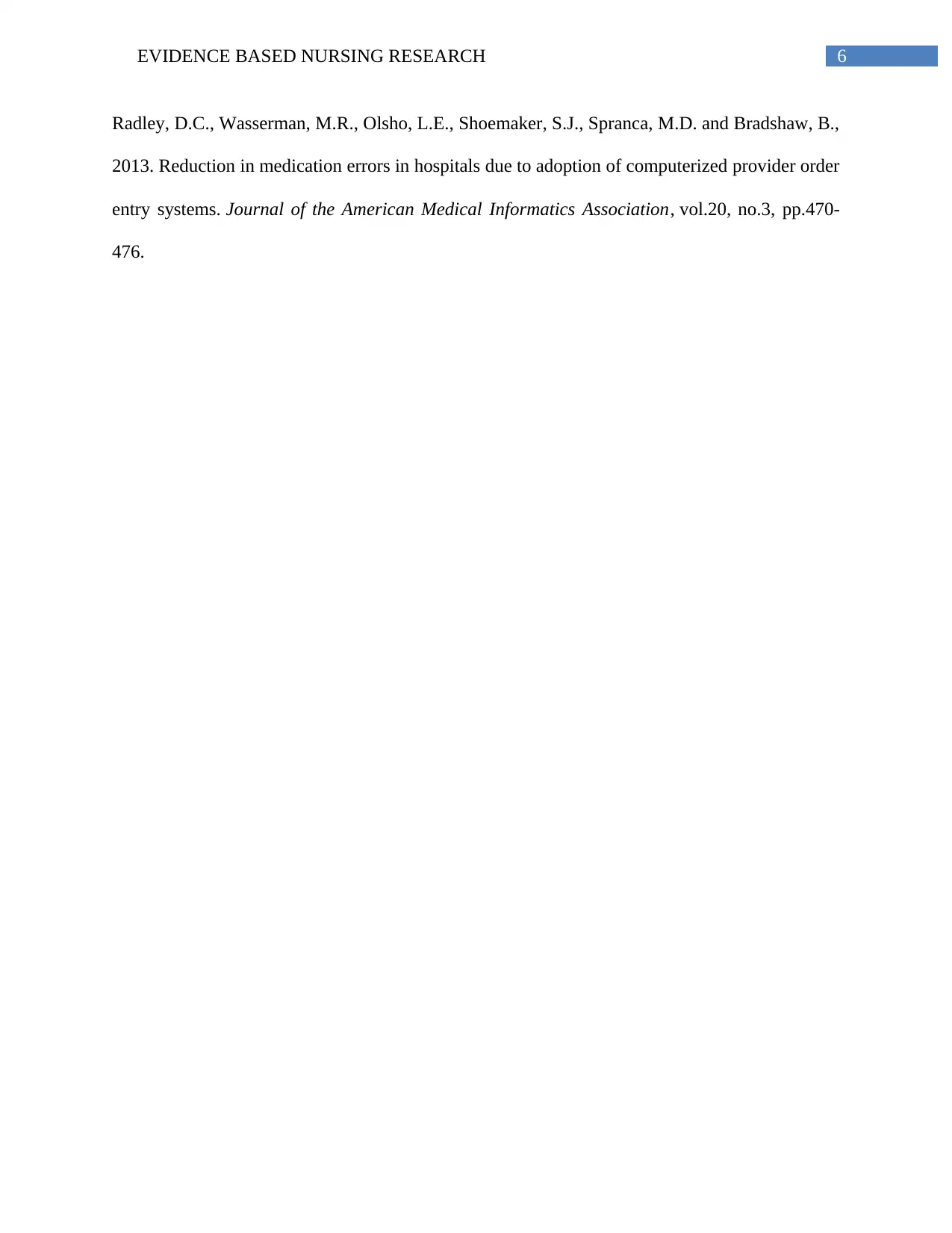
6EVIDENCE BASED NURSING RESEARCH
Radley, D.C., Wasserman, M.R., Olsho, L.E., Shoemaker, S.J., Spranca, M.D. and Bradshaw, B.,
2013. Reduction in medication errors in hospitals due to adoption of computerized provider order
entry systems. Journal of the American Medical Informatics Association, vol.20, no.3, pp.470-
476.
Radley, D.C., Wasserman, M.R., Olsho, L.E., Shoemaker, S.J., Spranca, M.D. and Bradshaw, B.,
2013. Reduction in medication errors in hospitals due to adoption of computerized provider order
entry systems. Journal of the American Medical Informatics Association, vol.20, no.3, pp.470-
476.
1 out of 7
Related Documents
Your All-in-One AI-Powered Toolkit for Academic Success.
+13062052269
info@desklib.com
Available 24*7 on WhatsApp / Email
![[object Object]](/_next/static/media/star-bottom.7253800d.svg)
Unlock your academic potential
Copyright © 2020–2025 A2Z Services. All Rights Reserved. Developed and managed by ZUCOL.





